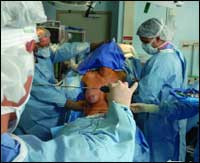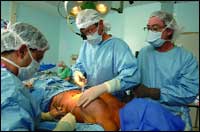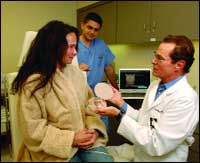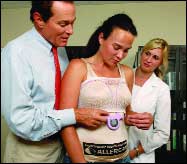 |
Not long ago, many in the medical field believed breast cancer was best treated with radical surgery. The more tissues cut away, the better the treatment, they held.
That approach to care lost its luster in the face of a growing body of scientific analysis of outcomes coupled with the introduction of less invasive cancer-fighting procedures. But the driving force behind it all was the chorus of patient voices—women who kept insisting that researchers and physicians develop alternatives to disfigurement.
Among the first to listen was G. Patrick Maxwell, MD, now senior partner of Maxwell Aesthetics (formerly Nashville Plastic Surgery) in Nashville, Tenn, and an assistant clinical professor of surgery at Vanderbilt University.
“I’ve always been keenly interested in protecting and even enhancing breast cancer patients’ sense of self-image—and, by and large, I’ve been able to do that simply by walking the path and keeping my eyes open along the way,” says Maxwell, hailed by many as a visionary in breast reconstruction and breast aesthetics.
“In my first year of residency training at Johns Hopkins Medical Center in Baltimore back in the early 1970s, I did a rotation in the breast service,” he continues. “Part of my responsibilities at the time included obtaining signed consent from patients to allow for a breast biopsy that potentially might be followed immediately after by radical mastectomy.
“The patient would be anesthetized and wake up afterward with either a
3-inch biopsy scar or half their chest missing and a skin graft in its place. Either way, these patients typically suffered emotional trauma from this. I was deeply affected by that, and that’s what put me on the path I then followed.”
Rethinking Breast Reconstruction
A stretch of that path early in Maxwell’s career led him to become an informal advocate for postoperative breast reconstruction. “Insurance companies and many general surgeons were opposed to the concept of breast reconstruction because, in those days, it was held to be meddlesome,” he says.
“Insurance companies didn’t want to cover it because they classified it as cosmetic, while general surgeons thought breast cancer survivors should live 5 years to prove the malignancy had been treated successfully before anyone should even be thinking about doing breast reconstruction.”
Then came acceptance of the new thinking about breast oncology. “We went from performing radical mastectomies to skin-sparing mastectomies, and gained the ability to provide highly sophisticated breast implants and perform a variety of flap procedures,” says Maxwell, first in the world to perform a latissimus dorsi free-flap surgery—an achievement, remarkably enough, that occurred while he was still in residency and shortly after he completed a fellowship in microsurgery at the University of California, San Francisco, with microsurgical pioneer Harry J. Buncke, MD.
 |
| Maxwell’s surgical artistry is revered around the world. |
Today, Maxwell’s most frequently performed procedures still involve breast surgery, but not just for cancer survivors. Now, far more of these cases entail revision work, with the majority of them representing women who have never had breast cancer.
“I see very challenging secondary and tertiary revision cases—reconstructive and aesthetic—that have had multiple operations, thin tissue, excessive scarring, and other problems,” says Maxwell, explaining that such patients come to him almost entirely by referral. “These women have reached a certain peak level of disappointment over the appearance of their surgically enhanced or otherwise modified breasts.
“For example, quite a few patients present with saline implants that were too big and, therefore, inappropriate for the particular composition of their body’s tissues. The implants subsequently caused thinning, stretching, and displacement.”
For revision and primary aesthetic work, Maxwell uses form-stable silicone-gel breast implants (available under FDA–approved clinical trials). He favors these mainly because they are highly cohesive, which, among other things, greatly diminishes the risk of capsular contracture.
 |
| Maxwell believes a clinically focused, experienced operative team helps him enhance patients’ surgical outcomes. |
“There is documentation now showing that highly cohesive gel, together with an aggressive textured surface, yields capsular contracture rates that are the lowest of any implants ever studied,” he says. “As for failure rates, European data indicate that more than 99% of these implants maintain their integrity 8 years after placement.
“Also, I like these implants because they give me control over not just volume but also over the aesthetic breast form itself. Studies have also documented a lower implant failure rate over time, compared to current gel devices.”
Earning Recognition
Maxwell’s involvement with silicone-gel breast implants is about as up-close and personal as it gets. In 1981, he designed the first-ever high-profile silicone-gel breast implant, and, since the mid-1980s, he has been involved to one extent or another in the design and development of just about every breast implant device bearing the Irvine, Calif-based Allergan (nee Inamed Corp, nee McGann Medical) brand.
Maxwell also invented (and patented) the concept of a texturized tissue expander; McGann Medical produced it and, in no time, it emerged as the world’s best-selling version of the familiar instrument. In all, Maxwell holds 10 US patents for medical devices.
Further, it was Maxwell who helped birth the notion that implants and surgical techniques could be paired with individual soft-tissue characteristics in aesthetic and reconstructive breast surgery—a concept that paved the way for the biodimensional approach, the method of using advanced dimensional analysis rather than volume when working with breast implants and expanders.
Clearly, Maxwell has built a vast trove of knowledge about breast enhancement and reconstruction. It is knowledge he has freely shared in more than 100 scientific articles (most of them dealing with anatomic descriptions, clinical applications, and aesthetic refinements of breast, face, and body contour procedures). He also has imparted this knowledge via countless lectures and live surgical demonstrations given in more than 20 countries.
To promote the exchange of knowledge, Maxwell in 2003 founded the Inamed Academy—now the Allergan Academy—and he continues to serve as chairman. The academy is an international educational entity charged with informing physicians and the public about the proper use of breast implants, and about fillers and Botulinum Toxin type A procedures. He also launched similar academies in China, Japan, South Korea, Malaysia, Mexico, Canada, and Brazil.
The entrepreneurial-oriented Maxwell also cofounded and remains a principal in skin care products-maker Integrative Aesthetics, and played a leading role in the development and marketing of the “Esteem by Naomi Judd” line of facial beauty aids. Moreover, he is a founder and board member of the Aspen Center for Integrative Health, a national nonprofit association of health care professionals, scientists, policymakers, and thinkers dedicated to creating a health care model more responsive to current and future physical, mental, societal, and environmental factors.
Accordingly, it should come as no surprise to learn that Maxwell’s name routinely turns up on “Best Doctor” and “Best Plastic Surgeon” lists, including those compiled by Good Housekeeping, Town & Country, W, More, Departures, Redbook, New York Times Magazine, and Vogue. Also unsurprising are the awards garnered by Maxwell throughout the years:
 |
| Maxwell and fellow Dr Allen Gabriel have collaborated on a computer-assisted analysis system to select anatomical cohesive gel breast implants. |
He has won the American Society of Plastic Surgeons Robert H. Ivy Society Award and the 2005 President’s Award, as well as the American Association of Plastic Surgeons James Barrett Brown Award. He also has been three times awarded both the American Society for Aesthetic Plastic Surgeons (ASAPS) Chul Song Award and the ASAPS Walter Scott Brown Award.
In addition to belonging to these three professional bodies, Maxwell also is a member of the American College of Surgeons and the Southeastern Society of Plastic Surgeons. Plus, he is an honorary member of plastic surgery societies in Canada, Japan, and South Africa.
In 2007, the US Congress approved a resolution honoring his visionary contributions to the field of medicine. Noteworthy: Maxwell is an acquaintance of former Senate Majority Leader Bill Frist, MD. The Republican lawmaker’s father, Thomas Frist Sr, MD, who founded Hospital Corporation of America, was Maxwell’s mentor.
Blending Practice Types
Maxwell recently evolved Nashville Plastic Surgery into Maxwell Aesthetics, a reworking that combines what he considers the best aspects of academic and private practice. The desire for a blended practice traces back to his time as a member of a Norfolk, Va, group headed by Charles Horton, MD, founder of Eastern Virginia Medical School.
“Although it was a private-practice setting, it was also an incredibly academically involved center of excellence for plastic surgery,” Maxwell remembers fondly. “Part of what helped this group be successful was its academic focus contained within a private-practice setting with a hospital relationship.”
Thus, when Maxwell left Horton’s group to start Nashville Plastic Surgery, he sought without hesitation to form a relationship with a hospital—in this case, not-for-profit Baptist Hospital, near Vanderbilt University. In 1989, his ties to Baptist Hospital led to the creation of a joint-venture research entity named the Institute for Aesthetic and Reconstructive Surgery (IARS).
 |
| Maxwell and nurse Amber Cruth, RN, utilize new technology to reduce postoperative pain and enhance healing. |
Under Maxwell’s leadership, the IARS soon began training Vanderbilt residents and offering fellowship programs. IARS—with its direct links to Maxwell’s private practice—also included a fitness center, a medical spa, and a consumer education center designed to develop public awareness of aesthetic plastic surgery options and to oversee support groups for patients who have experienced disfigurement from breast cancer or facial trauma.
“This arrangement enabled my practice to provide essential services for the total person—and this was 20 years before that concept caught on and became the industry it is today,” Maxwell says.
Baptist Hospital was acquired in 2002 by Ascension Health, which, following a post-takeover business assessment, decided to end several of the IARS’s consumer-education activities. (The Vanderbilt residents rotation and fellowship training program were unaffected.)
While accepting of this action, Maxwell was concerned enough by what it might portend for breast cancer patients that he and former medical school classmate Gerome Tannenbaum, MD—a nephrologist who successfully launched two renal dialysis companies that grew to more than 100 locations—decided to start a hospital company of their own.
The company Maxwell and Tannenbaum created was christened Diversified Specialty Institutes (DSI). “The purpose of DSI is to build freestanding plastic and reconstructive surgery/comprehensive breast hospitals,” Maxwell says.
“The first of these, DSI Bucks County Comprehensive Breast Care Institute, opened earlier this year just outside of Philadelphia. It is perhaps the most sophisticated hospital of its kind in the country,” Maxwell continues.
“It offers all aspects of onco-plastic surgery, from high-end diagnostic screening to treatment, provided by oncologic breast surgeons, plastic and reconstructive surgeons, radiation oncologists, pathologists, and many others. A medispa is included on the aesthetic plastic surgery side, and we have plans to add a bariatric service that will be capable of addressing the reconstructive aspects of bariatric procedures. Reconstructive services also will eventually be available for other areas of women’s health.”
Embracing Change
As Maxwell sees it, the most important advance for plastic surgery in the past 30 years has not been the introduction of new materials, techniques, or instruments, but a “return to the sound understanding of anatomy.” This understanding, he says, is what has enabled “the whole evolution of musculocutaneous flaps, microsurgery, craniofacial surgery, and minimal-scar aesthetic surgery. It also has allowed the introduction and progress of Botox and fillers.”
 |
| See also “Rebuilding the Temple” by Jeffrey N. Thaxton, MD, in the March 2006 issue of PSP. |
Indeed, Maxwell envisions volume-oriented fillers—combined at various levels with neurolytics and increasingly less-invasive procedures—as the coming big thing in plastic surgery. “The future of plastic surgery appears to be headed in the direction of ongoing self-image maintenance,” he says. “The use of volume-oriented fillers with neurolytics and minimal surgery will be just one aspect of that trend.”
What should plastic surgeons do today to capitalize on this trend and achieve success tomorrow? Answers Maxwell, “The environment now is becoming more and more competitive. To stand apart and make a name for yourself, you have to bring with you a true passion for the field of aesthetic plastic surgery, an ability to empathize with patients and understand what they want, and a willingness to stay abreast of innovation and to embrace it once the evidence in support of it becomes scientifically compelling enough. My advice is to be ready for change—and never shrink from it.”
The Private Side of Practice
 |
Maxwell Aesthetics, Nashville, Tenn, is based in a medical office building owned by Baptist Hospital, the institution with which the practice’s founder and senior partner—G. Patrick Maxwell, MD—has long enjoyed a mutually beneficial business relationship. Because the office is directly across the street from that hospital, patients can be admitted via overground pedestrian corridor if they choose to stay in the hospital postoperatively.
“I don’t use the hospital’s inpatient surgery suites nowadays; I use its outpatient facility just a few floors below my office,” Maxwell says.
An upscale hotel is located next door to the Baptist Hospital campus. As such, many of Maxwell’s reconstructive and aesthetic plastic surgery patients—and virtually all of those who come from out of the area—spend a few postoperative days recovering at the hotel, where they luxuriate in professional pampering and enjoy plenty of privacy.
Maxwell himself has been able to enjoy more private time these days. Until fairly recently, he was in surgery 3 full days per week—Tuesday through Thursday. Now he is in the operating room on Wednesday and Thursday and, occasionally, Tuesday afternoon.
Maxwell dedicates the time formerly spent on Tuesday surgeries for his diverse business and educational pursuits. Monday and Friday remain his office-consultation days.
The revamped schedule—coupled with the adoption of more efficient methods of practice—also leaves Maxwell more time for his wife, Stephanie, and his two children. Daughter Michael is grown and herself a parent, while son Julian is 5 years old.
Stephanie Maxwell is a skin care and medical-spa consultant. Although her work is unconnected with Maxwell’s practice, she advises the practice and helps implement new aesthetic services.
The schedule change also means more time for his outside interests. Before attending college at Vanderbilt University (and, later, Vanderbilt University School of Medicine), Maxwell enjoyed teenage competitive golf.
It was the rigors of student life in the hallowed halls of higher learning that forced him to set aside the drivers and 9-irons; only in the past several years has he found time to again take up the game. “Now my wife has gotten into playing golf, and my son is showing interest, too,” he says.
In addition to golf, Maxwell enjoys skiing. “We’re a very outdoor-oriented family,” he says. He and his wife enjoy world travel and share a passion for home restoration and remodeling.
“I’ve always loved architecture and, in fact, before I decided to become a plastic surgeon, I thought I would become an architect,” he reveals. “Being able now to restore old homes is a fun way for me to indulge that lifelong love of mine.”
Maxwell’s current home, newly redone with many Tuscan-style architectural elements, was featured on the cover of the August issue of Veranda magazine. However, for Maxwell, home improvements are just a hobby and not a sideline. “I rely on professional architects to apply their skills, and my family and I live in the homes rather than sell them,” he says.
Recently, Maxwell finished writing a consumer-oriented book on breast surgery. Titled Beautiful Breasts: Enhancing the Female Form, the tome is slated to arrive in bookstores early this coming year.
“It’s a what-everyone-should-know book that explains the new era of procedures, devices, and appropriate outcomes,” he says. Maxwell asserts that his book is needed to fill an information gap: Most existing texts on this subject aimed at the general public are either outdated or do not adequately delve into breast health issues, he posits.
“The main message of my book is that times have changed and that the breast-implant devices that received all the bad press and caused so much consumer anxiety back in the early 1990s have been superceded by vastly better technology offered to patients as part of a process of preoperative education, precise surgery, and defined follow-up care,” he says.
“Most importantly, it will help women understand that an attractive breast is not necessarily a breast that has volume and drama, but more so a breast that is consistent in form, is in proper proportion to the rest of the body, and is in good health.”
—RS
Rich Smith is a contributing writer for Plastic Surgery Products. For additional information, please contact [email protected].


